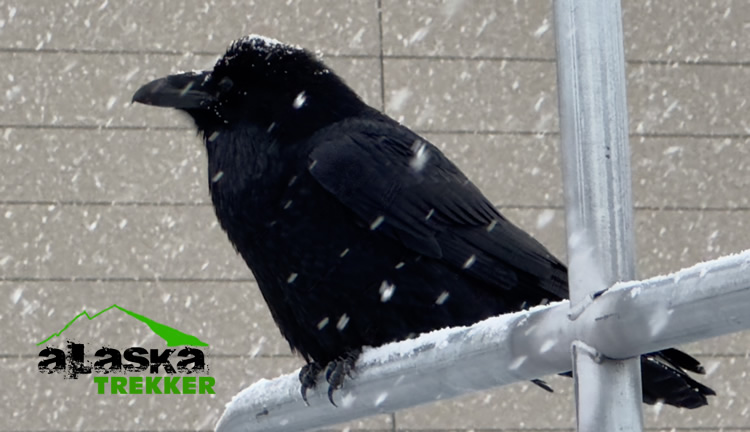Alaska Ravens
Known as the Trickster by Alaska Natives
Many Native Alaskan beliefs depict the Raven as a “trickster” spirit. Long recognized as one of the most intelligent birds, the Raven also has a less than savory image throughout history as a scavenger that does not discriminate between humans and animals. Ingenious and versatile, Ravens are members of the crow family, which includes jays and magpies. They are found everywhere in Alaska and adapt to very different terrain, from deserts to mountains- a feat requiring high intelligence.

Alaska Ravens learn to find food even in the harshest conditions, such as the dead of winter in Alaska. As scavengers, Ravens know how and when to take advantage of other animals to help them cadge a meal they couldn’t otherwise reach. In Yellowstone, bison that don’t survive the harsh winter attract coyotes, whose sharp teeth and strong jaws rip open the tough, frozen hides – making the meat accessible to watchful Ravens. They also have been seen following wild wolf packs to a kill; some stories even have Ravens flying ahead of the wolves to lead them to prey.
Description:
The largest member of the Crow Family, Alaska ravens average 24 inches tall, with a wingspan of 46-56 inches. Their coloration is all-black with a metallic shine of purple or violet that is noticeable in certain lighting conditions. The bill is large and stout. In flight, the tail appears wedge-shaped, which distinguishes it from crows.
Vocalization:
The Common Raven’s scientific name, Corvus corax, means “Raven croaker.” Noted for their calls, Bernd Heinrich writes in “Ravens in Winter”, how many researchers have studied Ravens and their vocalizations. One observation that was consistent throughout the findings is that Ravens have a wide repertoire of vocalizations.
These sounds, though, vary greatly from area to area. One bird’s quork was another bird’s kra, and was another’s caw. The researcher’s correlated Raven behavior with the calls, as well. These activities were then lumped into categories, nestling’s kaah for hunger, antagonist kaaa for defense, quork for territorial advertisement. But what the researchers also found while reviewing the sonograms of each other’s work, was that they, the researchers, often found little common ground. One’s “flight call” was another’s “territorial advertisement”.
Behavior:
Alaska ravens are strong fliers that can hover in place like American kestrels or soar like a hawk. They may fly like stunt pilots at times, doing partial barrel-rolls in flight. The birds may form large flocks of over several hundred individuals during their autumnal migration. A Raven is every bit as alert as a crow and possesses sharp eyesight and hearing. Ravens are considered among the most intelligent of all birds; like crows, they can learn to imitate a variety of sounds, including the human voice. In nature, their calls include guttural croaks, gurgling noises, and a sharp, metallic “tock”.
Diet:
Alaska ravens eat rodents, insects, grain, fruit, bird eggs and refuse. They consume much carrion, especially in winter and will even prey upon sick and injured animals. The Raven is an omnivorous species, meaning they will eat both plants and meat. As much as half of their diet can be live prey.
Raven Myths
The Alaska raven, like Mink and Coyote and other spirit beings of the Northwest mythology, was as fickle and unpredictable as nature and its seasons. Raven was a shapechanger, who could assume any form – human or animal. Raven was a glutton and trickster, but he showed pity for the naked people he found in a giant clamshell. His trickery brought them the essentials for existence in a harsh world – game and fish and fowl, fire, clothing, shelter – and with them the rituals that would protect them from the dark spirits lurking about.
The Raven stories are both entertaining – as Raven’s mischief often backfired, but also instructive – teaching us about the Northwest Indians’ way of life and the origin of their customs.
The Wikipedia page on ravens has some great information.




